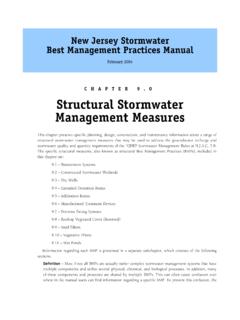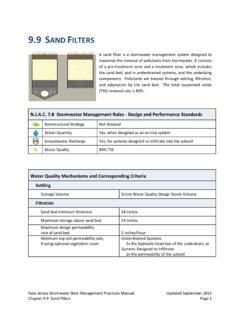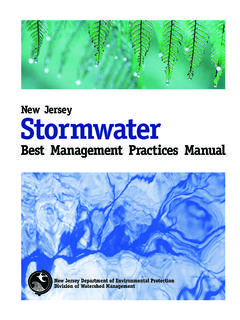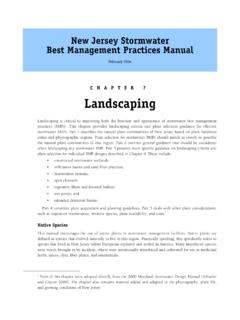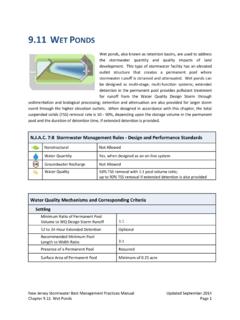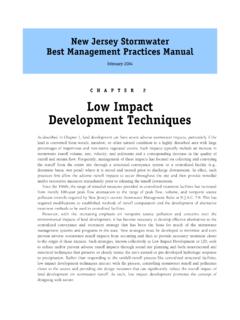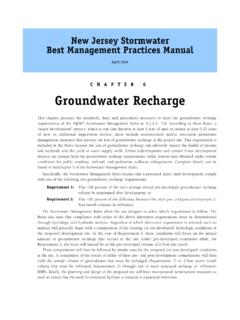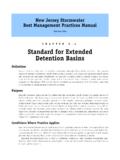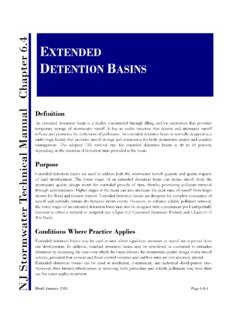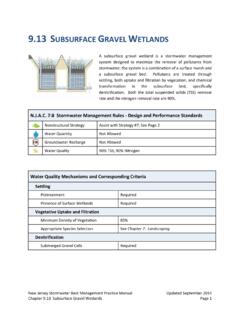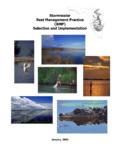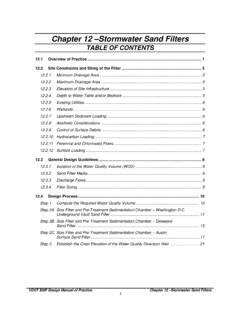Transcription of CHAPTER 9.2 Standard for Constructed Stormwater Wetlands
1 New Jersey Stormwater best management practices Manual February 2004. C H A P T E R 9 . 2. Standard for Constructed Stormwater Wetlands Definition Constructed Stormwater Wetlands are wetland systems designed to maximize the removal of pollutants from Stormwater runoff through settling and both uptake and filtering by vegetation. Constructed Stormwater Wetlands temporarily store runoff in relatively shallow pools that support conditions suitable for the growth of wetland plants. The adopted removal rate for Constructed Stormwater Wetlands is 90 percent. Purpose Constructed Stormwater Wetlands are used to remove a wide range of Stormwater pollutants from land development sites as well as provide wildlife habitat and aesthetic features. Constructed Stormwater Wetlands can also be used to reduce peak runoff rates when designed as a multi-stage, multi-function facility.
2 Conditions Where Practice Applies Constructed Stormwater Wetlands require sufficient drainage areas and dry weather base flows to function properly. The minimum drainage area to a Constructed Stormwater wetland is 10 acres to 25 acres, depending on the type of wetland . See text below for details. Constructed Stormwater Wetlands should not be located within natural wetland areas, since they will typically not have the same full range of ecological functions. While providing some habitat and aesthetic values, Constructed Stormwater Wetlands are designed primarily for pollutant removal and erosion and flood control. It is important to note that a Constructed Stormwater wetland must be able to maintain its permanent pool level. If the soil at the wetland site is not sufficiently impermeable to prevent excessive seepage, construction of an impermeable liner or other soil modifications will be necessary.
3 Finally, a Constructed Stormwater wetland must have a maintenance plan and, if privately owned, should be protected by easement, deed restriction, ordinance, or other legal measures that prevent its neglect, adverse alteration, and removal. Design Criteria The basic design parameters for a Constructed Stormwater wetland are the storage volumes within its various zones. In general, the total volume within these zones must be equal to the design runoff volume. An exception to this requirement is made for an extended detention wetland . In addition, the character, diversity, and hardiness of the wetland vegetation must be sufficient to provide adequate pollutant removal. Details of these and other design parameters are presented below. Constructed Stormwater Wetlands typically consist of three zones: pool, marsh, and semi-wet. Depending upon their relative size and the normal or dry weather depth of standing water, the pool zone may be further characterized as either a pond, micropond, or forebay.
4 Similarly, the marsh zone may be further characterized as either high or low marsh based again upon the normal standing water depth in each. Depending on the presence and relative storage volume of the pool, marsh, and semi-wet zones, a Constructed Stormwater wetland may be considered to be one of three types: pond wetland , marsh wetland , or extended detention wetland . As described in detail below, a pond wetland consists primarily of a relatively deep pool with a smaller marsh zone outside it. Conversely, a marsh wetland has a greater area of marsh than pool zone. Finally, an extended detention wetland consists of both pool and marsh zones within an extended detention basin. Table below presents pertinent design criteria for each type of Constructed Stormwater wetland . As shown in the table, each type ( , pond, marsh, and extended detention wetland ) allocates different percentages of the total Stormwater quality design storm runoff volume to its pool, marsh, and semi-wet zones.
5 In a pond wetland , this volume is distributed 70 percent to 30 percent between the pool and marsh zones. Conversely, in a marsh wetland , the total runoff volume is distributed 30 percent to 70 percent between the pool and marsh zones. Both of these zone volumes are based on their normal standing water level. However, in an extended detention wetland , only 50 percent of the Stormwater quality design storm runoff volume is allocated to the pool and wetland zones, with 40 percent of this amount (or 20 percent of the total Stormwater quality design storm runoff volume) provided in the pool zone and 60 percent (or 30. percent of the total runoff volume) provided in the marsh zone. The remaining 50 percent of the Stormwater quality design storm runoff volume is provided in the wetland 's semi-wet zone above the normal standing water level, where it is temporarily stored and slowly released similar to an extended detention basin.
6 As noted in Table , the detention time in the semi-wet zone of an extended detention wetland must meet the same detention time requirements as an extended detention basin. These requirements are presented in CHAPTER : Standard for Extended Detention Basins. The minimum diameter of any outlet orifice in all wetland types is inches. The components of a typical Stormwater wetland are illustrated in Figure Pertinent design criteria for each component are presented in Table Additional details of each type of Constructed Stormwater wetland and the components of each are described below. A. Pool Zone Pools generally have standing water depths of 2 to 6 feet and primarily support submerged and floating vegetation. Due to their depths, support for emergent vegetation is normally limited. As noted above, the pool zone may consist of a pond, micropond, and/or forebay, depending on their relative sizes and depths.
7 Descriptions of these pool types are presented below. New Jersey Stormwater best management practices Manual CHAPTER : Standard for Constructed Stormwater Wetlands February 2004 Page 1. Pond Ponds generally have standing water depths of 4 to 6 feet and, depending on the type, may comprise the largest portion of a Constructed Stormwater wetland . Ponds provide for the majority of particulate settling in a Constructed Stormwater wetland . 2. Micropond In general, a micropond also has a standing water depth of 4 to 6 feet, but is smaller in surface area than a Standard pond. A micropond is normally located immediately upstream of the outlet from a Constructed Stormwater wetland . At that location, it both protects the outlet from clogging by debris and provides some degree of particulate settling. Since a micropond does not provide the same degree of settling as a Standard pond, it is normally combined with a larger area of marsh than a Standard pond.
8 3. Forebay Forebays are located at points of concentrated inflow to Constructed Stormwater Wetlands . As such, they serve as pretreatment measures by removing coarser sediments, trash, and debris. They typically have normal standing water depths of 2 to 4 feet. B. Marsh Zone Marshes have shallower standing water depths than ponds, generally ranging from 6 to 18 inches. At such depths, they primarily support emergent wetland vegetation. As noted above, a marsh is classified as either a high or low marsh, depending on the exact depth of standing water. 1. Low Marsh A low marsh has a standing water depth of 6 to 18 inches. It is suitable for the growth of several emergent wetland plant species. 2. High Marsh A high marsh has a maximum standing water depth of 6 inches. Due to its shallower depth, it will have a higher standing water surface area to volume ratio than a low marsh.
9 It will normally support a greater density and diversity of emergent wetland species than a low marsh. C. Semi-Wet Zone The semi-wet zone in a Constructed Stormwater wetland is located above the pool and marsh zones and is inundated only during storm events. As a result, it can support both wetland and upland plants. New Jersey Stormwater best management practices Manual CHAPTER : Standard for Constructed Stormwater Wetlands February 2004 Page Figure : Constructed Stormwater wetland Components Source: Adapted from Schueler and Claytor 2000. This figure can be viewed in color in the PDF version of this CHAPTER available at New Jersey Stormwater best management practices Manual CHAPTER : Standard for Constructed Stormwater Wetlands February 2004 Page Table 1: Design Criteria for Constructed Stormwater Wetlands Type of Constructed Stormwater wetland wetland Design Feature Extended Pond Marsh Detention Minimum Drainage Area (Acres) 25 25 10.
10 Minimum Length to Width Ratio 1:1 1:1 1:1. Allocation of Stormwater Quality Design Storm Runoff Volume (Pool / Marsh / Semi- 70 / 30 / 0 30 / 70 / 0 20 / 30 / 50*. Wet*). Pool Volume (Forebay / Micropond / Pond) 10 / 0 / 60 10 / 20 / 0 10 / 10 / 0. Marsh Volume (Low / High) 20 / 10 45 / 25 20 / 10. Sediment Removal Frequency (Years) 10 2 to 5 2 to 5. Reverse-Slope Pipe or Reverse-Slope Pipe or Reverse-Slope Pipe or Outlet Configuration Broad Crested Weir Broad Crested Weir Broad Crested Weir * In an Extended Detention wetland , 50 percent of the Stormwater quality design storm runoff volume is temporarily stored in the semi-wet zone. Release of this volume must meet the detention time requirements for extended detention basins (see text above and CHAPTER ). D. Types of Constructed Stormwater Wetlands 1. Pond Wetlands Pond Wetlands consist primarily of ponds with standing water depths ranging from 4 to 6 feet in normal or dry weather conditions.
